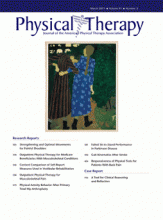Abstract
Background Previous studies focused on describing successful sit-to-stand (STS) performance in patients with Parkinson disease (PD). Little is known about why these patients fail to perform this transfer activity.
Objective This study aimed to determine the role of dynamic stability and limb support in governing successful STS performance in patients with PD and to determine the limits of recovery for discriminating between successful and failed STS trials.
Design This was a cross-sectional study.
Methods Twenty-eight patients with PD were instructed to perform the STS task. Kinematic data on 18 successful trials and 14 failed trials (when the patients fell backward) were collected with a motion analysis system. Dynamic stability was determined by the anteroposterior position of the body's center of mass (COM) relative to the base of support (BOS) and by the anteroposterior velocity of the COM relative to the BOS (VelocityCOM/BOS,AP). Limb support was characterized by the hip height (Heighthip).
Results The findings revealed no between-group (“risers” versus “fallers”) differences in dynamic stability. The fallers shifted their COM in a significantly more anterior position to compensate for their lower VelocityCOM/BOS,AP at seat-off. It was in the vertical direction that the fallers had significantly reduced peak COM velocity (VelocityCOM,vertical) and lower corresponding Heighthip than the risers. Results of a stepwise regression model showed that VelocityCOM/BOS,AP and Heighthip at the instant of peak VelocityCOM,vertical could best predict the STS outcome (success versus failure), with an overall prediction accuracy of 87.5%. The limit differentiating successful from failed STS trials was: Heighthip=−0.814 VelocityCOM/BOS,AP + 0.463.
Limitations All of the patients were community dwelling and had a moderate level of disease severity. The results cannot be generalized to those who are institutionalized or with advanced PD.
Conclusions Limb support and ill-timed peak forward COM velocity, rather than dynamic stability, play the dominant roles in determining successful STS performance in patients with PD.
Footnotes
All authors provided concept/idea/research design and writing. Dr Mak provided data collection, project management, fund procurement, participants, facilities/equipment, institutional liaisons, and consultation (including review of manuscript before submission). Dr Mak and Dr Yang provided data analysis.
The study was approved by the Ethics Committee of The Hong Kong Polytechnic University.
The study was supported by a Competitive Research Grant (GYG94), The Hong Kong Polytechnic University, and by National Institutes of Health/National Institute on Aging grant R01-AG029616.
- Received July 14, 2010.
- Accepted November 10, 2010.












